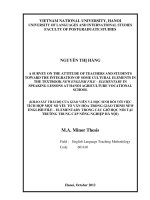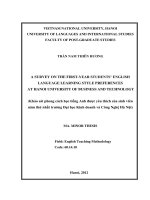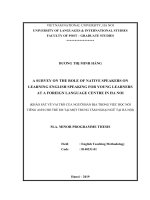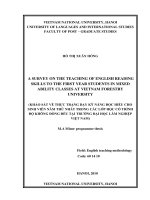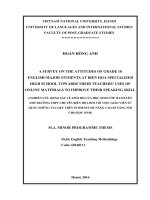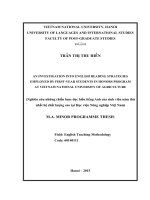A survey on the first year english majors using the basic spelling rules in learning english at vietnam national university of agriculture
Bạn đang xem bản rút gọn của tài liệu. Xem và tải ngay bản đầy đủ của tài liệu tại đây (681.02 KB, 53 trang )
VIET NAM NATIONAL UNIVERSITY OF AGRICULTURE
FACULTY OF EDUCATION AND FOREIGN LANGUAGES
BA THESIS
A SURVEY ON THE FIRST YEAR ENGLISH MAJORS’
USING THE BASIC SPELLING RULES IN LEARNING
ENGLISH AT VIET NAM NATIONAL UNIVERSITY
OF AGRICULTURE
KHẢO SÁT VỀ VIỆC SỬ DỤNG CÁC QUY TẮC ĐÁNH VẦN
TIẾNG ANH CỦA SINH VIÊN NĂM NHẤT NGÀNH TIẾNG ANH
TRONG VIỆC HỌC TIẾNG ANH TẠI HỌC VIỆN NÔNG NGHIỆP
VIỆT NAM
Student
: NGUYEN VAN TUAN
Student code : 621260
Major
: ENGLISH LINGUISTICS
Supervisor 1 : NGO TUAN ANH, Ph.D
Supervisor 2 : NGHIEM HONG NGAN, M.A
Hanoi – 2021
VIET NAM NATIONAL UNIVERSITY OF AGRICULTURE
FACULTY OF EDUCATION AND FOREIGN LANGUAGES
BA THESIS
A SURVEY ON THE FIRST YEAR ENGLISH MAJORS’
USING THE BASIC SPELLING RULES IN LEARNING
ENGLISH AT VIET NAM NATIONAL UNIVERSITY
OF AGRICULTURE
KHẢO SÁT VỀ VIỆC SỬ DỤNG CÁC QUY TẮC ĐÁNH VẦN
TIẾNG ANH CỦA SINH VIÊN NĂM NHẤT NGÀNH TIẾNG ANH
TRONG VIỆC HỌC TIẾNG ANH TẠI HỌC VIỆN NÔNG NGHIỆP
VIỆT NAM
Student
: NGUYEN VAN TUAN
Student code : 621260
Major
: ENGLISH LINGUISTICS
Supervisor 1 : NGO TUAN ANH, Ph.D
Supervisor 2 : NGHIEM HONG NGAN, M.A
Hanoi – 2021
ii
CERTIFICATE OF ORIGINALITY
I, the undersigned, hereby certify my authority of the study project report
entitled A SURVEY ON THE FIRST YEAR ENGLISH MAJORS’ USING THE BASIC
SPELLING RULES IN LEARNING ENGLISH AT VIET NAM NATIONAL UNIVERSITY
OF AGRICULTURE submitted in partial fulfillment of the requirements for the
degree of Bachelor in English Language. Except where the reference is
indicated, no other person’s work has been used without due acknowledgement
in the text of the thesis.
Hanoi, 2021
Nguyen Van Tuan
Approved by
SUPERVISOR
(Signature and full name)
Date:……………………
i
ACKNOWLEDGMENTS
At first, I am grateful to all teachers in the Faculty of Education and Foreign
Languages of Vietnam National University of Agriculture for allowing me to do
this graduation thesis.
Second, I would like to thank my sincere gratitude to my first supervisor, Ngo
Tuan Anh, Ph.D for his patience and enormous contribution to preparing my
graduation thesis. I am also very thankful to my second supervisor, Nghiem
Hong Ngan, M.A for her valuable feedback and comments. Without their
guidance, it would not be possible to complete my graduation successfully.
I also would like to delicate my special thanks to all my friends at Vietnam
National University of Agriculture, who have supported, cooperated and
provided me with valuable suggestions.
Last but not least, I also would like to express my great thanks to my family for
the sacrifice they have devoted during my studies.
ii
TABLE OF CONTENTS
CERTIFICATE OF ORIGINALITY ..................................................................... i
ACKNOWLEDGMENTS..................................................................................... ii
TABLE OF CONTENTS ..................................................................................... iii
ABSTRACT ......................................................................................................... vi
LIST OF ABBREVIATION ............................................................................... vii
LIST OF TABLES AND CHARTS................................................................... viii
PART 1: INTRODUCTION.............................................................................. 1
1.1. RATIONALE FOR THE STUDY ................................................................. 1
1.2.1. The aim of the study .................................................................................... 2
1.2.2. Research objectives ..................................................................................... 2
1.3. RESEARCH QUESTIONS (IN FORM OF QUESTIONS) .......................... 2
1.4. SCOPE OF THE STUDY .............................................................................. 2
1.5. SIGNIFICANCE OF THE STUDY ............................................................... 2
1.6. DESIGN OF THE STUDY ............................................................................ 3
PART 2: DEVELOPMENT ............................................................................... 4
CHAPTER 1: LITERATURE REVIEW .......................................................... 4
1.1. REVIEW OF THE PREVIOUS STUDIES ................................................... 4
1.1.1. Review of the domestic researches ............................................................. 4
1.1.2. Review of the international researches ....................................................... 4
1.2. REVIEW OF THEORETICAL BACKGROUND ........................................ 6
1.2.1 Definition of Spelling ................................................................................... 6
1.2.2. Definition of consonant ............................................................................... 6
1.2.3 Definition of ending sounds. ........................................................................ 7
1.2.4. Word stress in English ................................................................................ 7
1.2.5 The relationship between spelling and word stress, ending sounds,
consonant ............................................................................................................... 8
iii
1.2.6 Some the basic spelling rules in learning English ...................................... 9
1.3 Summary ....................................................................................................... 16
CHAPTER 2: METHODOLOGY ................................................................... 17
2.1. RESEARCH METHODOLOGY ................................................................. 17
2.2. RESEARCH SETTING/CONTEXT ........................................................... 17
2.3. DATA COLLECTION................................................................................. 18
2.3.1. Data collecting instruments ....................................................................... 18
2.3.2. Data collecting procedures ........................................................................ 18
2.4. DATA ANALYSIS ...................................................................................... 19
2.5. SUMMARY ................................................................................................. 19
CHAPTER 3: FINDINGS & DISSCUSSIONS .............................................. 20
3.1.THE CURRENT SITUATION OF THE FIRST YEAR ENGLISH MAJOR
STUDENTS’S USING THE BASIC SPELLING RULES IN LEARNING
ENGLISH ............................................................................................................ 20
3.1.1. The important factors when speaking English .......................................... 20
3.1.2. English language students are required to learn how to spell English...... 21
3.1.3. The importantce of pronunciation in communication .............................. 22
3.1.4. The students’ interesting English pronouciation ....................................... 23
3.1.5. The purposes of learning English spelling ................................................ 23
3.1.6. The resources students learn these English spelling rules ........................ 24
3.1.7. The locations where VNUA’s K65 English majored students often use the
basic spelling rules in learning English ............................................................... 26
3.2. THE EFFECTS OF FIRST YEAR ENGLISH MAJOR STUDENT’S
USING THE BASIC SPELLING RULES IN LEARNING ENGLISH AT VIET
NAM NATIONAL UNIVERSITY OF AGRICULTURE ................................. 28
3.2.1. Using English spelling rules affect students’ learning outcomes ............. 28
3.2.2. The effects of using English spelling rules for learners ............................ 30
3.3. SUMMARY ................................................................................................. 31
iv
PART 3: CONCLUSION ................................................................................. 32
1. RECAPITULATION ...................................................................................... 32
2. CONCLUSION REMARKS ........................................................................... 32
3. LIMITATIONS OF CURRENT STUDY. ...................................................... 33
4. SUGGESTIONS FOR FURTHER STUDY. .................................................. 34
REFERENCES .................................................................................................. 34
PART 5: REFERENCES .................................................................................. 35
APPENDIX ........................................................................................................ 37
v
ABSTRACT
This study is to investigate first–year English major students’ using the
basic spelling rules in learning English at Vietnam National University of
Agriculture. The main purposes of the study are to investigate the effectiveness
of using spelling rules on English learning and first-year English-majored
students in particular English at Vietnam National University of Agriculture. In
practical terms, research on this topic has helped teachers and English learning
to apply it finding in their learning. The study includes three parts: Part 1, the
introduction which states the rationale, aims, scopes, design and methods of the
research; Part 2, the development consists of three chapters. Chapter 1 is
literature review, chapter 2 shows methodology of the study and chapter 3
reveals the results with a comprehensive analysis on the data from the survey
questionnaire. Finally, part 3 presents the conclusions, the study’s limitations
and suggestions for further study. The results of the study reveal that a large
percentage of first-year English major students are very interested in English
spelling rules and their effects. In other words, along with other influencing
factors, learning English spelling rules had a positive effect on students' learning
outcomes, especially with speaking and listening skills. Moreover, it also helps
students learn all four English skills equally well.
vi
LIST OF ABBREVIATION
VNUA
: Vietnam National University of Agriculture.
SPSS
: Statistical Package for the Social Sciences.
i.e
: That is
vii
LIST OF TABLES AND CHARTS
Table 1: The table of the locations where VNUA’s K65 English majored
students often use the basic spelling rules in learning English ........................... 26
Table 2: The table of the frequency of using English spelling rules .................. 27
Table 3: The students’ typical English subject scores in the first semester ........ 28
Chart 1: The pie chart important factor when speaking English ........................ 20
Chart 2: Students’ opinions on the requiremnt of learning how to spell ........... 21
Chart 3: The pie chart of the important of pronunciation in communication ..... 22
Chart 4:The chart of the students’ interesting English pronouciation ................ 23
Chart 5: The pie chart of the purposes of learning English spelling ................... 24
Chart 6: The chart of resource students learn these English spelling rules ........ 25
Chart 7 : The chart of the effects using English spelling rules for learners ........ 30
viii
PART 1: INTRODUCTION
1.1. RATIONALE FOR THE STUDY
Moving towards the 21st century with the rapid development of science,
economy and knowledge, the process of globalization and integration has
profoundly influenced the development of nations, peoples, communities and
individuals. Vietnam is stepping up the industrialization and modernization of
the country to become a civilized, modern and internationally integrated
country. In the period when the country is on the verge of integration and
globalization, the English language is an essential means of communication for
everyone; the explosion of knowledge leads to a rapid change in all fields of
activity the movement of international stature, one of the changes in the change
of the field of education and training. Language learning in the current period
has become an essential need of all citizens in general and the young generation,
including students in particular. Learners who want to master English must
accumulate a lot of knowledge. No one can deny the fact that spelling rules play
an important role when it comes to learning and using English, because by
spelling, students can learn words. Learning and improving the foreign
language, especially English is extremely essential for English-majored students
at the Vietnam National University of Agricultural (VNUA) as this is their major. In
English lessons at colleges and universities, the teachers frequently do not have
enough time to introduce students to all new words. On the other hand, English has
many different reading ways so many students have difficulties in reading new
words. For all reasons above, this study was entitled: ‘A survey on the first year
English majors’ using the basic spelling rules in learning English at VNUA’.
1
1.2. AIMS AND OBJECTIVES OF THE STUDY
1.2.1. The aim of the study
This research aims at understanding the use of the basic spelling rules in
learning English performed on first-year students majoring in English at the
Vietnam University of Agriculture.
1.2.2. Research objectives
This study aimed at accomplishing two objectives. The first one is to
investigate the English majored freshmen’current situation towards the use of
spelling rules in learning English at VNUA. The second one is to find out the
benefits of spelling rules in learning English.
1.3. RESEARCH QUESTIONS (IN FORM OF QUESTIONS)
As there are several reasons and opinions for why using spelling rules
in the educational field in general and language learning in particular, the
current study attempted to address the following questions:
1, How do English majored freshmen use spelling rules in learning
English at VNUA?
2, What are the effects of using spelling rules on English majored
freshmen’ English learning at VNUA?
1.4. SCOPE OF THE STUDY
This study is limited to a specific scope, that is within the framework of
the VNUA, conducted on a 65-student group as the English majored freshman
(K65) at VNUA. The study focuses on the spelling rules learning and then, some
effectives will be shown in order to help students learn English better.
1.5. SIGNIFICANCE OF THE STUDY
This study aims to survey the effectiveness of using spelling rules on
learning English of first-year English-majored students at Vietnam National
University of Agriculture. In terms of application, research on this issue has
aided instructors and students, particularly English learners, in their learning.
2
1.6. DESIGN OF THE STUDY
Statement of thesis originality
Acknowledgements
Abstracts
List of abbreviations, graphs, tables and figures
Part 1: INTRODUCTION
Part 2: DEVELOPMENT
Chapter 1: Literature Review
Chapter 2: Methodology
Chapter 3: Findings & Discussion
Part 3: CONCLUSION
References
Appendix
Apart from abstracts, references & appendices, the study consists of three
main parts:
PART 1 - INTRODUCTION presents rationale of the study, aims and
objectives of the study, research questions, the scope as well as the significance
of the study.
PART 2 - DEVELOPMENT is divided into 3 chapters:
Chapter 1 - LITERATURE REVIEW – provides theoretical background
for the study including the definition of spelling, definition of consonant,
definition of ending sounds, and word stress in English.
Chapter 2 – METHODOLOGY describes the methodology used in the
research including the action research, data collection instruments, participants,
the procedures employed to carry out the research.
Chapter 3 - FINDINGS AND DISCUSSIONS - reports and discusses the
findings of the study.
PART 3 - CONCLUSION summarizes the main issues that have been
addressed in the study, points out the limitations, draws pedagogical
implications concerning the research topic and suggests several solutions.
3
PART 2: DEVELOPMENT
CHAPTER 1: LITERATURE REVIEW
This chapter mainly concentrates on the review of related literature
concerning spelling rules in English. It starts with several compact reviews of
related literature and research works conducted by both Vietnamese and others.
This is followed by how the previous scholars define and classify learning the
basic spelling rules of English.
1.1. REVIEW OF THE PREVIOUS STUDIES
1.1.1. Review of the domestic researches
Nguyễn Ngọc Nam (2015), a teacher of Research and Training Academy,
carried out the study ‘50 English spelling rules’ thesis. Importantly, as he
assumed, ‘learning to spell rules of English help learners write phonetics, read
English words correctly without using a dictionary, and speak English sentences
with fluent intonation like native speakers’. It is important, according to him, to
learn English spelling is absolutely practical and necessary, and it is really
necessary to build English vocabulary learning principles suitable for each
student.
According to Langmaster international educational organization’s website
(2018), in their “Rules and irregularities in English spelling” article, ‘the English
spelling has both very easy rules to follow, and some of them are very effective
and practical’. Spelling according to English rules must be applied consistently,
but there are some irregularities, which is the main reason that makes it difficult
for learners to spell, thus solving problems need to set out the rules and provide
some tools for learners to use in case of irregularities.
1.1.2. Review of the international researches
As mentioned by Prof. V. Chandra Sekhar Rao ().
(2018) ‘English Spelling and Pronunciation - A Brief Study’ Professor in
English, SITECH, Hyderabad ‘Learners of English have to understand that
4
there exists no perfect correspondence between the sounds (pronunciation) and
letters (spelling) in English. Letter or letter combination can represent more than
one sound as English spelling system is irregular and more complex. Therefore,
it needs special notations, i.e. IPA symbols to understand the intelligibility of the
pronunciation and the spelling-designed of the English words’. Learners need to
be familiar with all possible spelling rules and be aware of the many possible
letter-chord combinations due to master English spelling and pronunciation. In
short, all English learners should consult the English Pronunciation Dictionary
for a better understanding of the spelling and pronunciation of unfamiliar or
confusing word.
Through “Why spelling is important and how to teach it effectively” by
Virginia W. Berninger, University of Washington, Seattle, USA and Michel
Fayol, Université Blaise Pascal & CNRS, Clermont-Ferrand, France ‘Effective
spelling instruction (a) facilitates abstraction of phonological, orthographic, and
morphological regularities in words’, spelling knowledge might take the form of
rules, statistical patterns, or processes, and each of these types of information
has significant consequences for teaching. Spelling rules in English examples
While children are explicitly trained to utilize a wider range of spelling methods,
they are more likely to apply them successfully and selectively when writing.
According to Valerie Yule’s (2013), formerly academic at Monash, Aberdeen
and
Melbourne
Universities,
clinical
child
psychologist,
educational
psychologist mainly in disadvantaged schools, and teacher, researches in literacy
and imagination, in his ‘SPELLING RULES ON ONE PAGE’, he Assumed that
‘Writing the spoken word. 27 sounds have phoneme/grapheme correspondence.
Five sounds can be represented by either of 2 graphemes, five by 3 graphemes,
and one has six possibilities for spelling’.
There are 41 grafemes (spelling patterns) that can only be pronounced one
way, each grapheme has two ways to pronounce them, and seven graphemes
5
each have three pronunciations. Besides, 35 very common words with
unchanged irregular spelling, plus complicated foreign words, given names and
places. One-syllable-one-spelling-basic pattern for pronunciation, is also used as
literacy beginners. This includes simply e i o u for "long" the vowels, paired
with the 'short' vowels, e i o u, are a distinctive feature of the English language.
1.2. REVIEW OF THEORETICAL BACKGROUND
1.2.1 Definition of Spelling
‘Spelling is the ability to spell words in the correct way. It is also an
attempt to spell a word in the correct way’ (Collins dictionary, 2018).
‘Spelling is the way in which a word is spelled’ as Houghton Mifflin
Harcourt (2010) stated in “Webster’s New World College Dictionary, 4th
Edition”.
Specifically, spelling can be understood as reading each letter from a
group of letters and put them together to form rhyme and syllable (Soha
Vietnamese online dictionary, 2016).
The role of spelling in learning English
‘Spelling in English is very important. Knowing how to spell and
pronounce English correctly helps others understand what you are saying. It also
helps learners understand more of what they are reading. Spelling or
pronouncing English is considered the most perfect step to help learners conquer
English easily’ (hacknaotuvung, meohoctuvung, cachdanhvantrongtienganh.)
1.2.2. Definition of consonant
Consonant is clearly defined as Cambridge Dictionary “one of the speech
sounds or letters of the alphabet that is not a vowel. Consonants are pronounced
by stopping the air from flowing easily through the mouth, especially by closing
the lips or touching the teeth with the tongue” or “a basic speech sound in which
the breath is at least partly obstructed and which can be combined with a vowel
to form a syllable” in Oxford Dictionary. Additionally, Peter Roach (2009) is
6
defined as in English Phonetics and Phonology is that “if we make a sound like
s, d it can be clearly felt that we are making it difficult or impossible for the air
to pass through the mouth. Most people would have no doubt that sounds like s,
d could be called consonants”. Definition of consonants is shown in “How to
teach pronunciation” by Gerald Kelly “consonants are formed by interrupting,
restricting or diverting the air flow in a variety of ways”.
1.2.3 Definition of ending sounds.
In English, attention to ending sounds is a very important factor in
pronunciation. What are ending sounds? The learners can understand simply that
ending sounds are the letter sounds at the end of a word. Examples of these are: t
in cat, g in dog, n in pen, and d in hand. The ending sounds refer to one or more
consonants at the end of words. Ending sounds are codas.
Almost every English consonant appears word-finally, except for /h/, /w/
and /j/ (Cummins, 1998). Besides, English has a lot of complicated consonant
clusters, as mentioned previously, combining two, three and even four
consonants together in the onset and coda. This is commented as “quite unusual
for languages to have consonant clusters of this type” (Yule, 2006: 48). Yule
(2006: 47) states “The basic structure of the kind of syllable 13 founding
English words […] is shown in the accompanying diagram”
1.2.4. Word stress in English
When learners study English, word stress is one of the most important
factors that they have to spend their time studying and practicing. Students can
easily understand that it is often called stress to indicate how strong or weak the
sound is. The definition of word stress is shown simply in Harper Collins (2003)
Collins English Dictionary that “the stress accent on the syllables of individual
words either in a sentence or in isolation “. Additionally, there is a definition of
word stress is that “in English, we do not say each syllable with the same force
or strength. In one word, we accentuate ONE syllable. We say one syllable very
7
loudly (big, strong, important) and all the other syllables very quietly” according
to Put English Phonetics into Practice compiled by SzilágyiLászló in 2004.
There are two very important points about word stress:
- One word, one stress. (One word cannot have two stresses. So if you
hear two stresses, you have heard two words, not one word.)
- The stress is always on a vowel.
Word stress is your magic key to understanding spoken English. Native
speakers of English use word stress naturally. Word stress is so natural for them
that they don't even know they use it. Non -native speakers, who speak English
to native speakers without using word stress, encounter two problems:
- They find it difficult to understand native speakers, especially those
speaking fast.
- The native speakers may find it difficult to understand them.
1.2.5 The relationship between spelling and word stress, ending sounds,
consonant
‘The English alphabet is divided into two categories: Vowels and
Consonants.
Vowel:
a, e, i, o, u
The remaining sounds are consonants.
For example: b, d, c, m,v, k, r, s, t, g, h….
Some diphthongs: /ei/, /əµ/, /ai/, /aµ/, /ↄi/, /iə/, /µə/, /eə/ .
Stress identification mark
The sign in the sound is denoted by the sign (‘).
When writing phonetics or looking at the phonetic transcription of a word,
the accent mark (‘) helps to read English correctly, with correct intonation of the
word.
Therefore, the first and most important thing in order to speak English is
8
to know the position of the word stress.
When you have determined which vowel stress falls on, you will put a
sign (') on that sound, if there is a consonant in front of it, put an accent mark (')
before the consonant, otherwise put the stress mark right before it. vowel.
How to read stressed sounds?
The accented sounds (') before it are stressed. When reading these sounds,
it is necessary to ensure that all three factors are met: The stressed sound must
be read at a higher, longer, and louder volume than the unstressed sounds in the
sound. This will help to read an English word with a music-like rhythm, with
highs and lows.’( />consonants.html)
1.2.6 Some the basic spelling rules in learning English
According to Nguyen Ngoc Nam (2015) in Hoc danh van tieng anh, he
outlined some basic rules of English spelling.
‘Rule 1: The rule of recognizing the number of syllables of the word
Based on the number of negative integers appearing in that word, you can
know how many syllables the word has, so you can still type correctly.
For example
One-syllable word cat, bat, dog
Two-syllable word chicken, doctor
The 3-syllable word superman
The 4-syllable word supermarket, photographer
Rule 2: For words with the last correct vowel e
Words with the correct e vowel at the end of a sentence, we do not
consider the "e" sound as a syllable of the word
For example
One-syllable word late (late), hate (hate), like (favorite)
9
Two-syllable word: climate, roommate
Three-syllable word: estimate, graduate
4-syllable word certificate
Exception: If the vowel "e" is preceded by a consonant 1", we still
consider "e" a syllable of the word.
For example
Two-syllable word table , able
Words with 3 syllables: article , possible
4-syllable word accessible
Rule 3: Double vowels, long vowels
Double vowel sound "o" will be written as /ou/, sound "a" will be written
as /ei / sound "i" will be written /ai/
Long vowels: The "e" sound is written /i/
The “u” sound can be read as a diphthong or a long vowel depending on
the correct consonant before it
With single-syllable words, formed as vowel + consonant (except r) +e,
the vowel will be read as a diphthong or a long vowel.
For example
The sound is read as a diphthong /ou/ note
The "a" sound read as a diphthong /ei/ late
The "i" sound reads as a diphthong/ai/ nice
The "e" sound is pronounced as a long vowel /i:/ scene
Reading convention:
With diphthongs, you say the first vowel and then quickly float to the
second.
With long vowels, you stretch slightly longer than usual
Rule 4: How to read the "ogue" syllable
Words ending in "ogue are words with one syllable, the "o" sound is
10
always read as a diphthong. Loi spelling in phonetic transcription will remove
the /oʊ/ sound and keep the 'g' consonant.
For example
Vogue /voug/
rogue /roug/
For words with 3 or more syllables ending in "ogue", we stress the next
syllable one syllable away from "ogue".
For example
Catalogue
Dialogue
Analogue
Apologue
Monologue
Sinologue
Rule 5: Rule of stress
When reading a syllable with two or more syllables, we need to pay
attention to how the word stress is stressed, so that we can pronounce the word
most accurately when reading the stressed syllable, reading aloud more clearly
than the unstressed syllables. stress. Unstressed syllables in the tone to be read
with a descending, fast, and gliding voice
Here are some rules for reading two-syllable words
Two-syllable words with the form ''o'' + consonant + ''us'' the stress falls
on the first syllable
Example: focus
Two-syllable words have the form ''a'' + consonant ''us'' the stress falls on
the first syllable.
Example: gradus
Two-syllable words with "i" form + consonant + "us'' stress falls on the
11
first syllable
Example: minus
With two-syllable verbs, the stress falls on the second syllable
For example: be'gin ,be'come, for'get
Exception. 'answer; 'enter (break in), "offer (offer), 'open
With two-syllable nouns, the sound falls on the first syllable
Example: 'children', 'hobby', 'standard'
Exception. Ad'vice (advice), ma'chine (machine), mis'take (mistake)
With two-syllable nouns, the stress falls on the first syllable
Example: 'children, 'hobby', 'standard
Exceptions: Ad'vice (advice), ma'chine (machine), mis'take (error).
With two-syllable adjectives, the stress usually falls on the first syllable
For example: 'busy', 'lazy', 'lucky'
Exceptions A'lone (lonely), a'mazed (surprised).
With compound verbs the stress falls on the second syllable
For example: under'stand (understand), be'come (become).
In words with the words “sist, cur vert, test tain, tract, vent, self” the stress
falls on the syllable containing the problem.
For example: e'vent (event), sub tract (onward), pro test (objection), in'sist
(insist), maintain (maintain),
Words containing the suffix "ee, eer, ese que, esque, ain" have the stress
on the syllable containing it.
Example agree (agree), volunteer (volunteer), urique (different)
Exception: committee, 'coffee enormous'
With words that contain the ending-ic, -ish, -ical,- sion, -tion, -ance, ence, -idle, -lous, -far, -ience, id, -eous, -acy, -fan , -fcy then the stress of the
word falls on the syllable before it
12
Words with prefixes like "dis, re, un, des, im, ex" are usually unstressed
Examples: dis'cover (discover), des;troy (destroy), re'cord (record)
Exceptions 'underpass,' "underlay"
With compound nouns and compound adjectives, the stress usually falls
on the first syllable
For example: 'birthday,' 'airport,' 'bookshop,' 'airsick', 'homesick'.
Exception. duty-free (tax free), => with compound adjectives, connected by…,
the stress usually falls on the second syllable.
When adding the suffixes ment, ship ness, -erior, hood, ing, -en, ful, -able,
-ous less, the word stress does not change Words ending in graphy ate, gy. -cy,
ity, phy, -al, in the sound will fall on the third syllable from the bottom.
Examples: eco'nomical (economics), de'moracy (people), tech'nology
(technology), ge'ography (geography), pho'tography (photography), investigate
(im'mediate investigation) (right away).
Rule 6: Rules for recognizing short vowels and long vowels
There are some rules that can easily recognize short vowels, long vowels
in English to be able to pronounce better.
Words that have one vowel sound and are not at the end of the word are
short vowels.
For example
bug /bəɡ/
thin /θɪn/
cat /kæt/
job /ʤɒb/
bed /bɛd/
ant /ænt/
act /ækt/
Exception: Exceptions are the words “mind” and “find .”
13
-When the word has a vowel sound and that vowel is correct at the end of
the word, it is a long vowel
For example
Go/gəʊ/
No/nəʊ/
In a word where there are two vowels next to each other, the first vowel
will be the long vowel, the other is usually silent.
For example:
Rain /reɪn/: rain
Tied /taɪd/:forced
Seal /siːl/: seal
Boat /bəʊt/: ship
A word that has one vowel and is followed by two similar consonants is a
short vowel.
For example:
Dinner /ˈdɪnə(r)/: dinner
Summer /ˈsʌmə(r)/: summer
Rabbit /ˈræbɪt/: rabbit
Robber /ˈrɒbə(r)/: robber
Egg /eɡ/: egg
When a word has two similar vowels next to each other, we pronounce
them as one long vowel:
For example:
Peek /piːk/: peek
Greet /ɡriːt/: hello
Meet /miːt/: meet
Vacuum /ˈvækjuːm/: vacuum cleaner
Exception: If two consecutive similar vowels are followed by the
14
consonant "r", then this recognition rule does not apply.
For example:
Beer /bɪə(r)/: beer
-If in a sentence there are two consecutive "o" vowels, it will change into
many different sounds:
For example:
Poor /pʊə(r)/:poor
Tool /tuːl/: tools
Fool /fuːl/: stupid
Door /dɔːr/: door
-When the consonant "f, l, s,b, d,m,n, g, p" comes after a short vowel, we
need double the consonant "f,l,s,b,d,m,n" ,g,p” up
For example:
Ball /bɔːl/: ball
Staff /stɑːf/: staff
Pass /pɑːs/: pass
Tall /tɔːl/: tall
Different /ˈdɪfrənt/: different
Collage /ˈkɒlɑːʒ/: colleague
Compass /ˈkʌmpəs/: compass
Rabbit /ˈræbɪt/: rabbit
Manner /ˈmænə(r)/: manner
Summer /ˈsʌmə(r)/: summer
Happy /ˈhæpi/: have fun
Hollywood /ˈhɒliwʊd/:
Suggest /səˈdʒest/: suggestion
Odd /ɒd/: strange
-The consonant "y" is read as /i:/ at the end of a single-syllable word
15
